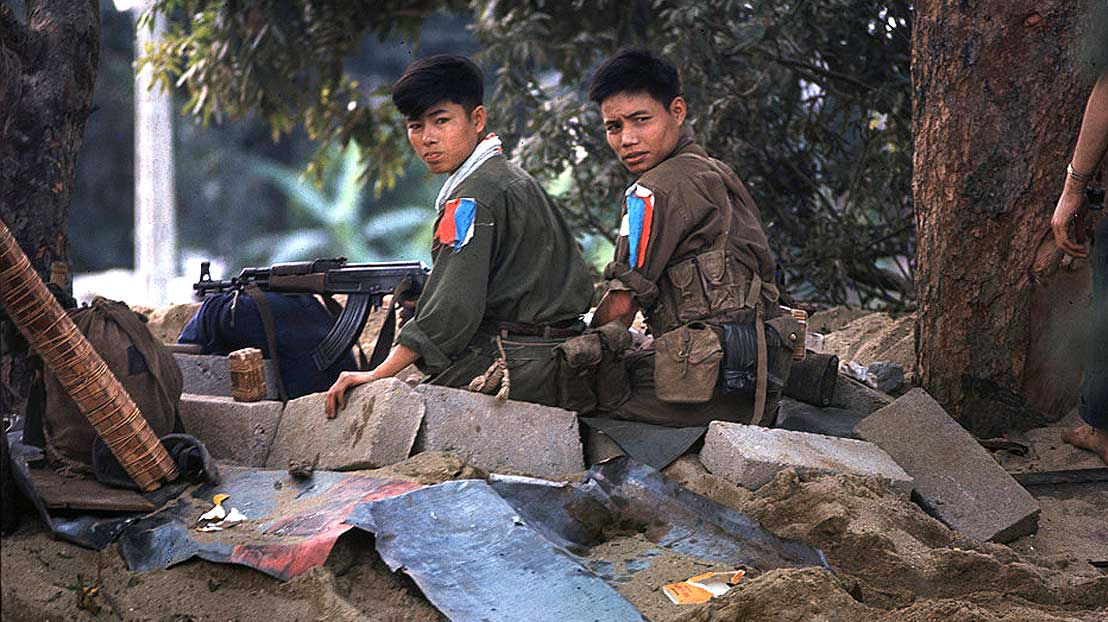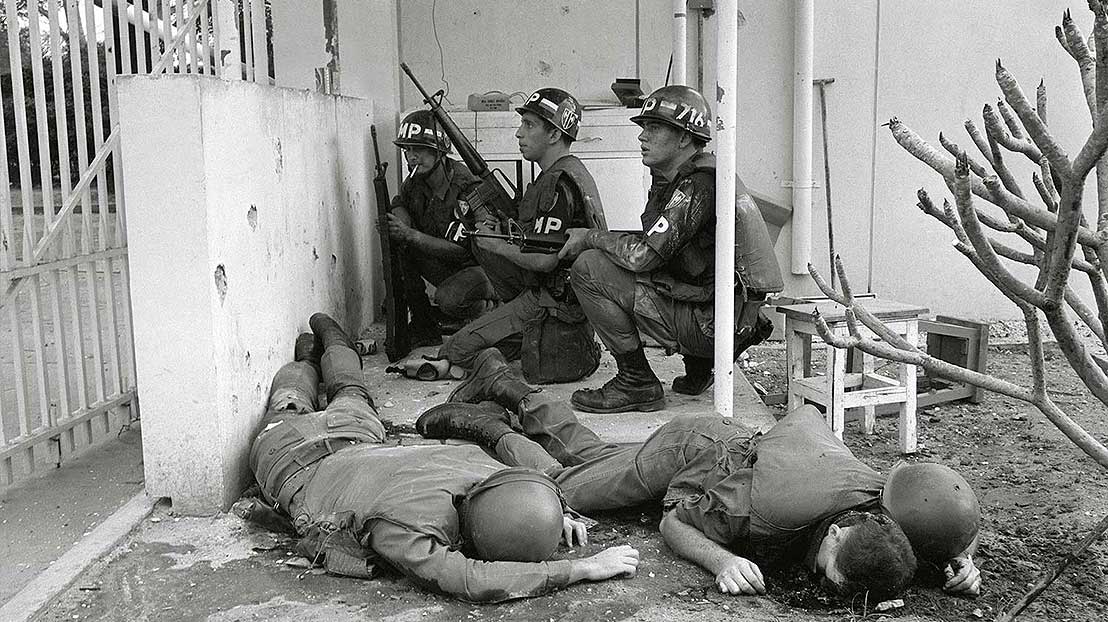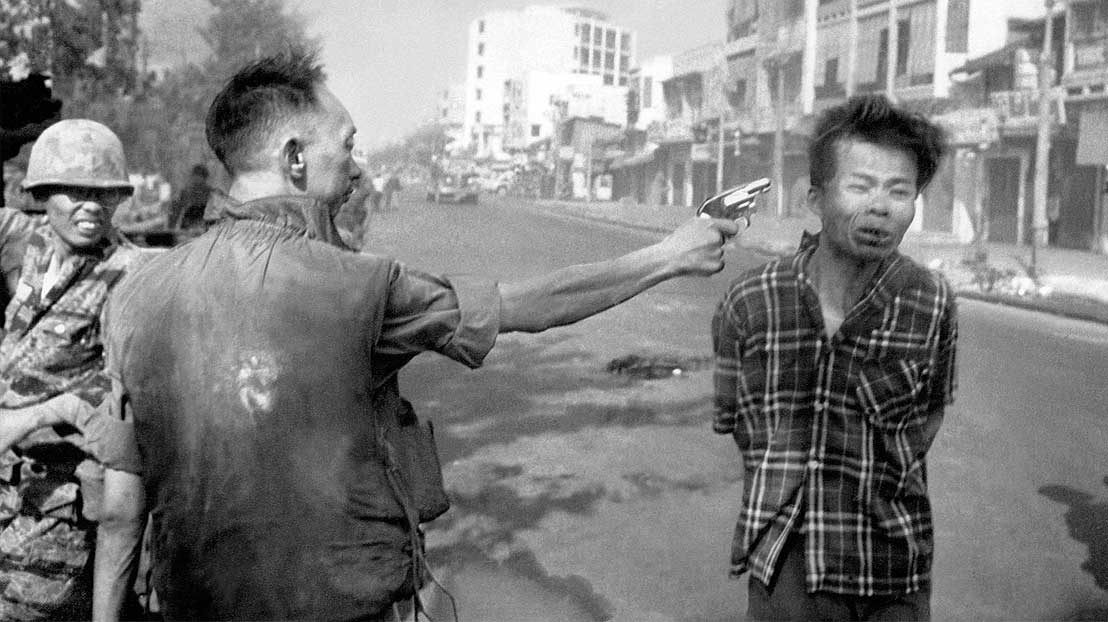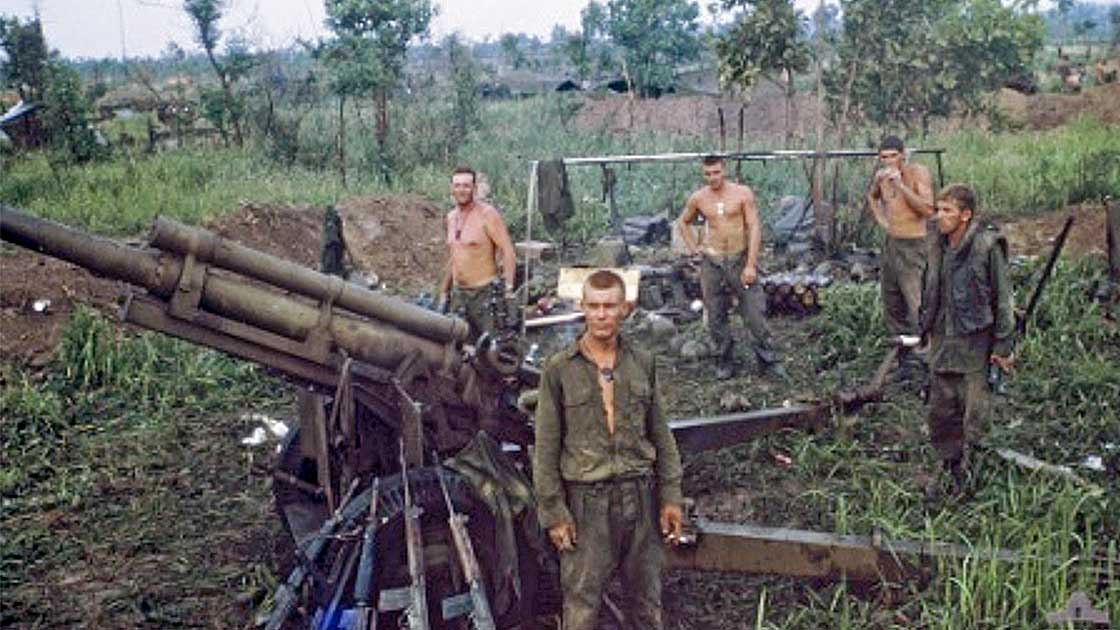Major Bernie Gaynor (Ret.) discusses the battles of fire support base Coral and Balmoral during the Vietnam War. He provides a detailed account of the events that took place during the 25-day period in 1968. Major Gaynor highlights the significance of these battles in Australian military history and emphasizes the challenges faced by the Australian forces. He also discusses the inadequate planning, lack of understanding of enemy strength, and other issues that arose during the campaign. He concludes with a reflection on the casualties, the impact of these battles, and what can happen when planning suddenly meets reality.
Captain Obvious statement: this page contains war photos.
TRANSCRIPT:
(This transcript is derived from an automated process. The video recording is authoritative.)
And I'm going to speak tonight about a little piece of military history that Jewel was keen to cover something in the Vietnam War. And so it's the battle, the battles of fire support based coral and Balmoral. Who's ever heard of those? Terrific, wonderful. So I'll go through what happened there. It's a neat little piece of Australian history that no one knows much about, but by the end of it you'll all be experts, I'll tell you that. So Ode was very nicely done. Thank you very much. Here we go.
Audience member:
So being artillery, where's your hearing aids?
Major Bernie Gaynor (Ret.):
I'm sorry, you have to speak up.
(laughter)
Alright, the battles of fire support base is cor Balmoral 12th of May to 6th of June, 1968. So we're talking about 25 days. Who can remember back to 1968 like it was yesterday? Alright, so '68 was busy times, busy times. And just think when I'm going through this, what it'll be like in Australia today if these sorts of events occurred and these sorts of casualties occurred, how would Australia cope? Anyway, so the background to the fire support base was the big picture and the biggest thing which occurred in 68 was a Tet Offensive on the 30th of Jan, 1968, the Tet Offensive
The Tet Offensive was shocking.

So all of a sudden on the 30th of June, 68, 80 4,000 Viet Con with many thousands of regular NVAs and soldiers attacked all over South Vietnam. So they're South Vietnam from top to bottom and attacks just erupted all over the place all at the same time, including in the capital Saigon.

Here's pictures of what was happening there. So there's some, they're South Vietnamese soldiers, they are South Vietnamese soldiers, there Americans there casualties left, right and centre.

That's a famous photo of a couple of dead US military police with other military police coming up to sort 'em out.

People were massacred, left, right and centre. The massacres at Hui, remember the city of Hui 10,000 were rounded up by the North Vietnamese and executed within days. It was shocking stuff. There was blood mayhem and chaos all over the show. That's a famous photo who's seen that photo before. This is the police chief inside Saigon. And this is the police barracks were raided by a North Vietnamese party and a whole bunch of his mates and their families were all rounded up and executed and he knew about it and that was one of the North Vietnamese that was captured and they brought him to him and he just blew him away just like that. Bang. And that was one of the most famous photographs of the Vietnam War.

So this full out attack to knock over South Vietnam, the communist lost about 45,000 people. It was an enormous casualties. How would you feel like in the next week or so if 45,000 enemy, how would we cope with that? So 45,000 were killed. South Vietnamese lost about three and a half thousand. The Yanks lost about 2000 and civilian losses were in the thousands. It was just horrendous.
Where were we when? So their Saigon there, we basically had a full brigade there if for those that are familiar with the military, we had three infantry battalions there numbered very opportunistically, one, two, and three, the first, second, and third battalions of the Royal Australian Regiment. And they were basically based down here and it's being and up at province up here. So there's Saigon there, which was the main area of attack. And in the te offensive there were two particular battles there, which on the first of Feb and the 18th of Feb involving three R. So we were in it to a little bit on the political front. If you recall the political front, the US secretary was concluding there's no military plan. President Johnson said, okay look, I'll negotiate with the North Vietnamese we'll call partial halt. And then he says, I'm not going to go for reelection again.
The North Vietnamese realising that the losses they were taking, he said, yeah, sure we are prepared to negotiate. And so on the 10th of May, that's when the Paris Peace talks started. If you can recall those, the fastest that those were on the military front, even as though were talking about peace Vietnamese, were pouring 12,000 troops per month down the Ho Chi Minh Trail towards the south, an old time plo torque peace over here and fight the war over there. They did that all the time. And then on the 5th of May, so when was the te offensive end of January, so it's now the 5th of May. They then do it again. They start a second Ted offensive all over South Vietnam again, 119 locations. And again they lost thousands, they just got smashed. So at this point, one A TF one Australian task force, the brigade is directed to move to Binwang province as part of a plan to block enemy operations and to intercept enemy forces moving to or from Saigon mission shut down the enemy supply and withdrawal roots pertaining to Saigon and the area that we were moving into, it was known that there were five communist regiments in the area with more expected to pass through.
So it was basically a line of supply we were being sent in to cap and stop them using it. So it's busy stuff. So here's what the enemy were. We had a regiment, regiment, another regiment, got a battalion, got all these infiltration groups, you've got callous rifle companies. Basically it was a full division, a full division of enemy that we were moving into the area with. So that's what we were to do. So we're down here, it's the first Australian brigade level operations in World War ii and we're moving up here to cut that route. And we've got in the Australian task force, we've got one and three RAR, we've got 12 field regimen artillery with two batteries, and we've got a squadron of APCs. And we had a United States self-propelled battery of artillery as well. Eight inch stuff with nice guns.
Oh yes, they were very nice guns. So it all gets down to this day, Sunday, the 12th of May, Sunday, the 12th of May. And the plan is, so if you have a look, so that yellow circle, this is now it. And so there's three areas of operations, aos they're called. So there's Bondi here, which has got fire support based coral in it. You've got Newport here with a fire support base there Balmoral, and you've got AO JI AO Manly over here with a fire support base in there as well. That was the big plan. So what happened, right? So the task was to secure the fire support base with the infantry. So we're talking about here. So we're moving into ao, Bondo Bondi in order to set up fire support base coral moving there, the US infantry are there and fly in one of the infantry companies from three RAR, then fly in the entire first battalion and the remainder of three RAR then fly in the guns of 1 0 2 battery and 1 61 field battery, which is New Zealanders plus bits and pieces, say infantry in first, then bring in the guns, that sort of stuff.
The guns don't like being out there on their own. We feel sort of vulnerable and ill at ease. And so the role of infantry is to protect the artillery if you didn't know. So no infantry here anyway. So protect the fire support base with some infantry and then let the infantry move out and establish their own positions and then the road convoys would come up and fill in the gaps. So that's the plan. Sounds like a good plan. Everybody happy with that plan? Hands up those who are happy with that plan. Sounds great. Terrific. Let's see what happens. Righto. The reality was that there was inadequate vague orders, poor landing zone selections and there were subsequent confusions and then there were changes throughout. So you're moving and you've got one day to occupy the real estate and then set up and it just didn't work.
So the artillery recon arrived at midday, more confusion. They said, oh, we don't like this site. We'll go and have a look for another site. And while they're looking around for another site, the US chinooks bring in the first guns who dumped them at the first site saying, well we've got to put 'em somewhere. So the Kiwis get dumped and off the chinooks go, three RAR begins to fly in and then the artillery recon finds a better position. So the kiwis were dumped down here, kiwi artillery, and then they found the better artillery position, which was that one. So that actually became fire support based coral.
The other battery was then delivered to the new location. So we've now got the artillery split by about one and a half, two Ks and then in comes the infantry and the headquarter elements and the last elements arrive just on dusk. So here here's some photos of what it looked like. So that's the US Chinooks bringing in the M two A 2 1 0 5 millimetre. So you can see the country, it's flat scrubby sort of country. It's been cleared. So that's all right. Big big stores coming in, a bigger helicopter stuff, arriving at fire support base, more stuff coming in. And there's a shot of fire support base from above. Basically what you've got there, you've got a circular element there and there's gun pits there. Everybody's digging in. So that's what it looks like, right? So by last light at the first block, you've got the kiwi guns sitting over there somewhere and you've got three companies from one of the battalions.
Then you've got a whole bunch of people at the actual fire support base itself. You've got companies are scattered around and the last elements arrived just on dusk and there was not much of a sense of urgency about things. So a small bulldozer had started to build the gun position so the guns would be protected by a wall of earth and stuff was beginning to happen. And so basically this is what it looked like. So you got the fire support base coral here. You've got 1 0 2 field battery, you've got headquarters of the guns, you've got a mortal platoon, you've got elements of the infantry. And then you've got other companies from the infantry have moved out and they're now beginning to go into the areas and patrol. And then off to the southwest you've got the kiwi guns down there all scattered around. And this has all happened in the space of one day.
At the beginning of the day, no one was there at the end of the day. That's where everyone was all, there's two people on the battlefield. There's you and the other side. The other side aren't done and they're not blind. They see what's going on and so they see the guns being floating in. So they go, let's go and see what's going on. So they conduct a recon and they go, let's smash them while they are unprepared and while they are all over the place, now's the time to hit them. So a quick attack from the north, he sees that the guns in a battery, there's six guns and they're all pointing to the east. So he said, right, we're going to come in from the north at 90 degrees so that we don't go straight into their muzzles. And then it all started at five 30 5:30 PM The first NVA patrol bumps into a one RAR patrol about two and a half K north and there's a bloody shower of shot and one NVA is killed six hours later, it's now getting on towards midnight.
One RAR company is hit by a salvo, RPGs and machine gun fire and two of our blokes are killed. The company calls for artillery support. Three of the six guns are then turned around to the north to provide fire support for them. And then it really starts to happen. So it's now just after midnight on and it's now Monday the 13th. And the one R, our mortar crew, they spotted NVA patrol and engaged him with machine gun fire three enemy killed at 1 45 a century on the mortar position, sees what's coming and this is what he calls over the radio. There's at least 400 ies only 15 metres away, all gibbering.
And then it happened. Bang. The fire support base is in hit with a barrage of mortars and rockets. The mass ranks of 2 7 5 infiltration battalion attack one RR mortar platoon was the first to receive and they just basically the north end went straight over the mortars. They didn't have time to fire the mortars, they basically had to pack up and move out and they lost 5K in eight wounded in no time flat. The enemy then swept onto towards the guns which were protected by earth buns. The were using their personal weapons rifles, submachine guns, machine guns to defend. The guns are also firing the guns themselves at point blank range firing he straight at the enemy to keep them off the front Left gun number six gun was overwhelmed. The guys had to pull out the bit from the breach and withdraw and the enemy captured the gun.
So gun number six was then continually sprayed with machine gun fire for the rest of the night. And one of the other guns was permanently put on it so that if it moved a second we'd just fire at the gun so they couldn't turn that gun and use it on us. At the Mortal platoon, Lieutenant Jensen called the New Zealand artillery onto me, onto me. I want the rounds onto me, we are being overrun. So the artillery came straight down 20 mils from them. The enemy tried to then use our mortars against us. That didn't work. And then he called for a second lot of artillery. And this time he got splint X straight across the position splint X, who knows what splint X is? This is splint X. That is a splint X dart, a round of an artillery 1 0 5 millimetre round of splint X has about 4,000 darts in that.
And you fire it and you detonated at the muzzle and you've got four of that, 4,000 of those going out like that. If you are in front of it, it will ruin your day. I can guarantee you that. So that's what we were using. The remaining guns on the gun position were firing splint X to clear the North Vietnamese off the position. How big are they? How big are they? Better nail that length. And if you sort it, it's crimped on the tail. So it's sort of like got flight feathers. Does it go? Oh look, they're extremely inaccurate. So as soon as the projectile burst and releases the splint X look, it'll go a couple of hundred metres, but they found some of the North Vietnamese pinned to trees afterwards. It just nailed there with the darts. So the splints really ruined the North Vietnamese time.
And then came the United States gunship, spooky and puffed the magic dragon and spooky drops flares and puffed the magic dragon and has got three mini guns. And there they are there. So that's what it looks like. So one of 'em is dropping flares and the other one's doing circles and that's the guns going. That's what it sounds like, the mini gun. Just you hear that sound, you go, oh that's a nice sound. I'm glad I'm not underneath it. Yeah, that's how they worked. So the North Vietnamese were now on the back foot. The fighting continued until dawn and then they began to withdraw a counter attack by the gunner to get their gun back was made. And they did the North Vietnamese had tried to destroy it with a satchel charge. The gun was damaged but not destroyed. And it's now on an exhibition at the Australian War Memorial in Canberra at 8:00 AM the North Vietnamese broke contact and were pounded by artillery and airstrikes as they withdrew casually. So all funds started what? Midnight? Yeah, midnight. It's over by 8:00 AM We've lost five killed and 28 wounded. If that happened today, look, it's small beer compared to World War I and World War ii. But today if that happened today you'd be devastated. Anyway, we counted 52 bodies around the fire support place captured one wounded prisoner and there were numerous blood trails indicating that other people have been dragged away. So that's pictures of the battlefield. And what do we got?
And there's a picture there. So you can see that's the earth bending, protecting a gun. That's what the gun position looked like. That's M two A two with the bun around it. That number six gun after it was recaptured with some happy gunners there, they got their gun back. That's it again. And that's the gun now in the Australian War memorial, right? So it's now Monday, later in the day another fire support base was established, if you recall. So we're in Bondi and that was all at Coral. So everything was happening there at Coral with the kiwi guns there. They then move into JI and establish wrong. They go into Manly and establish the fire support base at ji. That's the nice thing that happens.
And then the road convoy started to come in from the south, a big driving all through the night they started to arrive. So we've now got APCs and United States self-propelled artillery. And in the next couple of days the fire support bases are substantially reinforced with the rest of our troops and our people then start actively patrolling the areas. So that's one of the APCs and N one 13 armoured personnel carrier. And then, so this is Sunday and Monday, it's now Thursday, the second major enemy attack occurred. So big attack again, they've penetrated the lines, they're into the pits before the attack is held. Two further attacks have launched over the next couple of hours. Both were held at the perimeter at 6 45. The North Vietnamese broke contact again pounded by an artillery. As they withdrew, we lost another five killed and 21 wounded and we counted 34 killed around the position on that same day.
We then started to get our tanks centurion, who's familiar with centurion, so that the sense started arriving. Tell we've got the splint X, as you've seen, armour have got canister. So canister is slightly different. Canister. The canister round, you've got long rods in it and they've all been scored. So when the round detonates at the muzzle, the rod then breaks into small little cylinders, metal cylinders and they just rattle through the jungle. And those rounds were excellent at clearing the jungle when you couldn't see what was going on. A couple of rounds of armoured canister and you could see everything. It was quite wonderful.
So on the Friday, three RER moved out, established a new fire. So we've now got coral there on the Sunday. We've got that on. When did I say that was the Monday and it's now the Friday. And they've gone to establish fire support based Balmoral up there. And then the next day we've now got armoured vehicles moving out and they have a minor contact with the Vietnamese. And then on the Sunday, another North Vietnamese battalion hits bmal as usual. The attack begins with an intense and accurate bombardment of mortars and rockets. We lose two killed and 14 wounded. Another attack has also launched against coral at the same time. So bmal iss being hit the north, coral's being hit the south and both of them fail. Fail by now. We know what to expect and we're pretty well set up. As one of our blokes said they never had a chance.
So that's what Bemal looked like. And so you've got guns, you've got inventory companies, all the good stuff. If you know what the symbols mean, you'll find that highly interesting. Another night attack repelled. We've got centurion, we've got iTill, we've got aircraft, we lose 2 14, 6 North Vietnamese killed. Then D Company, one arm moves out and then they're going to clear the position and it's believed that there's an extensive enemy bunker position out there. And then what happened was the first combined infantry armour attack by Australians since the second World War. So there's a bunker system out there, the tanks with the infantry and they're going to go and clear 'em out. The tanks we used, the canister one I told you about. So they just stripped the jungle right off the position so you can see where all the dugouts are. And then the infantry go in with flame throwers and grenades and all the other good stuff that you carry around and do the job de company break contact after dusk and returned to coral.
So we gave them a bit of a stick, didn't lose any casualties and returned home. We're pretty happy. Then we then experienced another heavy attack against bmal. A faint was made on one side and then the main enemy attack came in against the other side and it was over the same open ground that had been used in the first attack. Solid defensive fire machine guns, artillery, mortars, 50 cal tank canister. What do you think happened to the attack didn't last very long. Helicopter gunships and spooky and puff, the magic dragon came in. And same old story at dawn, the North Vietnam, me broke contact. And with Drew two centurion with infantry cleared up enemy parties trapped in B 52 bomb craters. So B 50 twos have been bombing in the area and some North Vietnamese had occupied those bomb craters to avoid the canister and everything else.
And our tanks and entry went out there and took care of them and they just backfilled in the bomb craters to bury the bodies. And we counted over 42 killed, got seven captured right? So it's all happening. See on Thursday, sea company goes out on a patrol, they dismount make contact with North Vietnamese in more bunkers. Our blokes are pinned down. There are only two working tanks left, but out they go canister, he eight bunkers are destroyed. Helo gunships, artillery come in, enemies, the infantry is extracted and the force withdrawals. Two coral, we lost one killed seven wounded North Vietnamese. Lost about 45 further attacks. And at this point we've done our job and we begin to withdraw back down to Fwi province. And the last elements depart the AO on the 6th of June. Total Australian casualties over those 25 action pack days. Were 26 killed.
Summary enemy lost it. So if you can read that. So we reckoned they lost about 267, maybe another 67 wounded prisoners. War detained, surrendered, captured a whole bunch of weapons and food and stuff. And we lost 26 killed over those times issues. So the issues of this particular campaign, first of all the beginning was just, it was a shocker in terms of planning. It really was. It was not a good day for Australian military planners. And we were flipping lucky not to get rolled by that first initial attack. The North Vietnamese were quite correct, hit 'em while they got only one leg on their ground and their trousers are down around their ankles. You get 'em while they are unprepared and embarrassed. We didn't fully understand enemy strength and capacity, inadequate orders, appalling flying and then defence. What defence, we were lucky to get away with it. Here are some of the young blokes, young Australians, young fellas at the time, 18, 19, 20 at good young blokes. God bless 'em. And that was it. So an hour ago you knew nothing about the battles of fire support based coral and bmal. You now know that over those 25 days in 1968, our fellows were up to their armpits in snapping alligators and it was busy time and we lost a lot of young blokes and we gave the North Vietnamese a lot of stick. Any questions?






